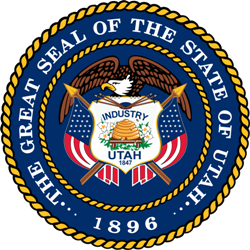Third Party Turnout Strong in Utah’s CD-02 Special
Only three Beehive State U.S. House elections since 1932 saw more support for third party and independent candidates in races with two major party nominees on the ballot

The heavily Republican district only saw a slight relative gain in support for the Democrats (State Senator Kathleen Riebe lost to Celeste Maloy by 23.6 points) vis-à-vis the 2022 general election (when Stewart defeated Nick Mitchell by 25.7 points).
In the 2023 special, five third-party and independent candidates shared 8.9 percent of the vote with Libertarian Brad Green leading the way with 2.7 percent followed by Constitution Party nominee Cassie Easley (2.2 percent), January Walker of the United Utah Party (1.8 percent), and independents Perry Myers (1.4 percent) and Joe Buchman (0.8 percent).
This 8.9 percent ranks as the 11th largest support for third party and independent candidates out of the 148 Utah U.S. House general and special elections since statehood in which both Republicans and Democrats fielded nominees on the ballot.
[Republicans did not field a candidate in 1896’s At-Large race and Democrats failed to do so in the state’s 3rd CD in 1982 and 1998].
The 2023 CD-02 special also demonstrated the fourth largest support by this metric since 1932 behind only:
- 1994, CD-02 (18.3 percent): Perennial candidate and mining explosives company executive Merrill Cook won 18.3 percent on the Independent Party of Utah ticket. [Cook would later win two terms in the U.S. House as a Republican].
- 2006, CD-03 (10.1 percent): Constitution nominee Jim Noorlander (8.8 percent) and Libertarian Philip Hallman (1.3 percent).
- 2017 special, CD-03 (16.4 percent): United Utah nominee Jim Bennett (9.3 percent), independent Sean Whalen (3.1 percent), Libertarian Joe Buchman (2.5 percent), and Independent American Jason Christensen (1.6 percent).
Third parties also had a comparatively strong run for a generation in Utah U.S. House contests from 1904 through 1930:
- 1904, At-Large (11.4 percent): American nominee Ogden Hiles (6.7 percent) and Socialist W.H. Shock (4.7 percent).
- 1906, At-Large (17.2 percent): American Thomas Weir (13.6 percent) and Socialist Homer Burt (3.6 percent).
- 1908, At-Large (16.1 percent): American Charles Douglas (12.1 percent), Socialist Charles Crane (3.9 percent), and independent B.J. Donohue (0.1 percent).
- 1910, At-Large (18.5 percent): American Allen Sanford (13.7 percent) and Socialist James Smith (4.8 percent).
- 1912, At-Large (28.3 percent in a top-two election): Progressives S.H. Love (10.1 percent) and Lewis Larson (9.9 percent), Socialists Murray King (4.1 percent) and William Knerr (4.0 percent), and Socialist Labor nominee Elias Anderson (0.2 percent).
- 1930 special, CD-03 (13.5 percent): Liberty nominee George Lawrence (13.2 percent) and Socialist Otto Parsons (0.3 percent).
- 1930, CD-03 (13.2 percent): Liberty nominee George Lawrence (13.0 percent) and Socialist Otto Parsons (0.3 percent).
However, it is premature to suggest this strong showing for non-major party candidates in a single Utah special will translate into support up the ballot in next year’s presidential race across the country. The nation’s two other U.S. House special elections this year (VA-04 and RI-01) only had major party nominees on the ballot.
Follow Smart Politics on X/Twitter.
